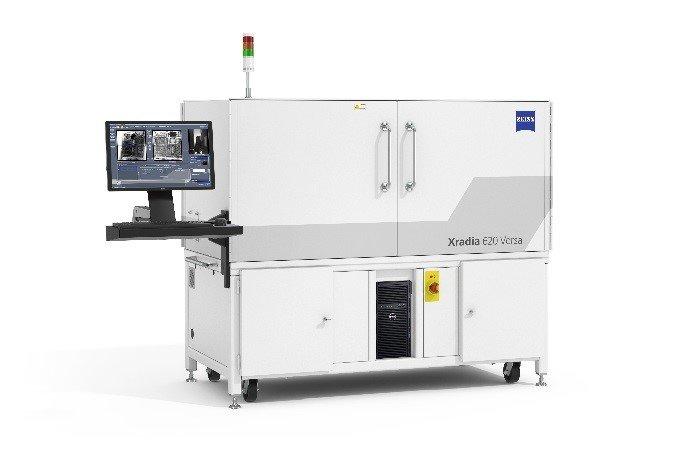Leading researchers and scientists across the world rely on the signature Resolution at a distance (RaaD) capability of ZEISS Xradia Versa microscopes, ensuring the highest resolution is maintained across longer working distances, to produce remarkable scientific insights and discoveries. The rapid rate of technology advancements today requires fast analytical instruments that can keep up the pace. The ZEISS Xradia 600-series Versa is designed for this challenge.
ZEISS Xradia 610 & 620 Versa with improved source and optics technology
The two biggest challenges in X-ray computed tomography are maintaining resolution on large sample sizes even at long working distances while simultaneously maximizing resolution and X-ray flux for greater throughput. Both instruments address these challenges: they provide a high-power X-ray source for significantly higher X-ray flux. This leads to faster tomography scans and therefore up to two times higher throughput – without compromising spatial resolution.
Benefits for a broad range of application fields in advanced research and industry
Academic shared-use facilities as well as industrial customers will derive maximum value from the faster image acquisition of these versatile instruments. By serving more users with different requirements and improving instrument utilization, these facilities will make the microscopes accessible to everyone and accelerate their research and discovery.
RaaD capability enables researchers to non-destructively characterize the 3D microstructure of materials in controlled environments to understand the impact of different factors such as heating or compression (in situ experiments).
The ZEISS Xradia 600-series Versa provides insights into the morphology of energy materials and their behavior under operating conditions. RaaD technology allows intact battery cells to be imaged at high resolution – enabling longitudinal studies of aging effects, across hundreds of charge cycles.
In electronics and semiconductor industries, users typically perform structural and failure analysis for process development, yield improvement and construction analysis of advanced semiconductor packages.
In the additive manufacturing industry, typical X-ray microscopy applications include studying detailed shape, size, and volume distribution of particles in powder beds to determine appropriate process parameters, as well as surface roughness analysis of inner structures that cannot be accessed by other methods.
In the raw materials industry, the new ZEISS Xradia Versa X-ray microscopes provide the most accurate 3D nanoscale support for digital rock simulations, laboratory-based diffraction contrast tomography (LabDCT), and multiscale imaging at faster run times.
In life sciences, the ZEISS Xradia 600-series Versa enables faster and higher resolution imaging allowing researchers to study soft tissue such as neural tissue, vascular networks, cellular structures, ligaments, nerves; mineralized tissue such as bones; and plant structures such as roots and cellular structures.
Continuous improvement and upgradeability
ZEISS X-ray microscopes are designed to be upgradeable and extendible with future innovations and developments to protect our customer’s investment. This ensures the microscope capabilities evolve with the advancements in leading edge technology. From ZEISS Xradia Context microCT, to ZEISS Xradia 500/510/520 Versa, and now with the addition of ZEISS Xradia 610/620 Versa, users can field-convert their systems to the latest X-ray microscopes.
ZEISS is an internationally leading technology enterprise operating in the fields of optics and optoelectronics. In the previous fiscal year, the ZEISS Group generated annual revenue totaling more than 5.8 billion euros in its four segments Industrial Quality & Research, Medical Technology, Consumer Markets and Semiconductor Manufacturing Technology (status: 30 September 2018).
For its customers, ZEISS develops, produces and distributes highly innovative solutions for industrial metrology and quality assurance, microscopy solutions for the life sciences and materials research, and medical technology solutions for diagnostics and treatment in ophthalmology and microsurgery. The name ZEISS is also synonymous with the world’s leading lithography optics, which are used by the chip industry to manufacture semiconductor components. There is global demand for trendsetting ZEISS brand products such as eyeglass lenses, camera lenses and binoculars.
With a portfolio aligned with future growth areas like digitalization, healthcare and Smart Production and a strong brand, ZEISS is shaping the future far beyond the optics and optoelectronics industries. The company’s significant, sustainable investments in research and development lay the foundation for the success and continued expansion of ZEISS‘ technology and market leadership.
With approximately 30,000 employees, ZEISS is active globally in almost 50 countries with around 60 of its own sales and service companies, more than 30 production sites and around 25 development sites. Founded in 1846 in Jena, the company is headquartered in Oberkochen, Germany. The Carl Zeiss Foundation, one of the largest foundations in Germany committed to the promotion of science, is the sole owner of the holding company, Carl Zeiss AG.
Further information at www.zeiss.com
Carl Zeiss Microscopy GmbH
Carl-Zeiss-Promenade 10
07745 Jena
Telefon: +49 (3641) 64-3161
http://www.zeiss.com/microscopy
PR
Telefon: +49 (3641) 64-3402
E-Mail: kristin.unger@zeiss.com
